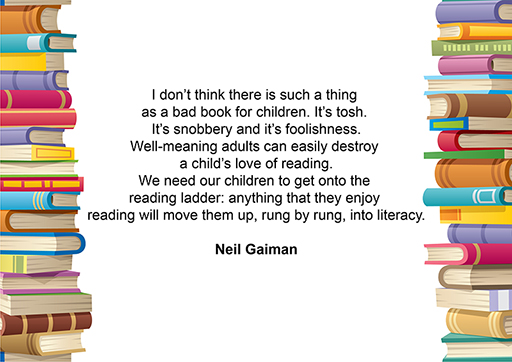1 Reluctant readers
As Neil Gaiman, the author, asserts in the quote in Figure 1, well-meaning adults shape children’s love of reading by framing reading in various ways. He suggests that creating an implicit hierarchy of reading materials can hold learners back, by profiling the enduring tradition of classic, approved, or significant authors in school and not recognising that what matters is each young reader’s choice and interests. Gaiman’s views are underscored by research into less engaged readers, who are often perceived by their teachers as ‘reluctant’ despite enjoying reading at home, in part perhaps because they haven’t found texts of interest to them in school (Hempel Jorgensen et al., 2018).
Children perceived as reluctant readers may appear to lack enthusiasm for reading, which means that even though they can read, they do not choose to do so in school. In assigned reading time they may appear unfocused, flick the pages, and keep getting up to swap their books. During reading aloud time, these children, who are likely to have low self-efficacy as readers, may pay limited attention to the text being read. When opportunities arise for talking about texts, such readers often play a subtle listening game, or seek to ensure that they are not noticed. If these young people have positioned themselves or have been positioned as ‘reluctant’ and disinterested for many years, this represents a real challenge. No one can make children find pleasure in reading or choose to read voluntarily and if it is perceived as ‘required’ this will put off those who are less confident or disengaged. Nonetheless, educators can entice, invite, model and share their pleasure in volitional reading and over time, with focused determination and skill, positively influence children’s engagement in reading. You will look at the ways in which to do this in more detail next.

